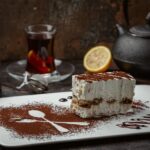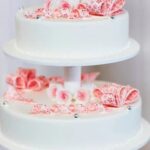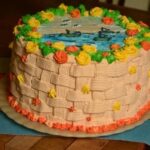Have you ever wondered “how do you make cake decorations” that look as beautiful as they taste? Cake decorating is an art form that allows bakers to express their creativity and elevate their baked goods to a whole new level. From intricate designs made with fondant to delicate piping of buttercream, there are countless ways to adorn your cakes with stunning decorations.
Cake decorators rely on a variety of tools and supplies to bring their creations to life. Understanding the different types of cake decorations, such as fondant, buttercream, and royal icing, is essential for mastering the art of cake decorating. In this article, we will explore the techniques and ideas you need to create professional-looking cake decorations in your own kitchen.
Whether you’re a beginner looking to learn the basics or a seasoned baker hoping to expand your skills, this comprehensive guide will provide you with step-by-step instructions, creative ideas, and troubleshooting tips for achieving beautiful and professional-looking cake decorations. So, let’s dive into the world of cake decorating and discover how you can take your baking game to the next level.
Essential Tools and Supplies for Cake Decorations
When it comes to cake decorating, having the right tools and supplies is essential to creating professional-looking designs. Some of the basic tools you will need include:
- Offset spatula: This tool is essential for spreading icing on the cake and creating smooth surfaces.
- Piping bags and tips: These are used for creating various designs with buttercream or royal icing, such as borders, flowers, and writing.
- Fondant smoother: If you plan on working with fondant, a fondant smoother will help you achieve a seamless finish on your cakes.
- Bench scraper: This versatile tool is great for creating clean edges and smoothing out frosting on the sides of your cake.
- Turntable: A turntable makes it much easier to frost and decorate a cake evenly from all sides.
In addition to these tools, there are also various supplies that are necessary for cake decorating, including different types of icing, food coloring, edible decorations such as sprinkles or edible glitter, and molds or cutters for shaping fondant. With the right tools and supplies, you can create beautiful cake decorations with ease.
Mastering the Art of Piping Buttercream Decorations
Considerably Increased Role in Space Management
| Tools | Supplies |
|---|---|
| Offset spatula | Icing |
| Piping bags and tips | Food coloring |
| Fondant smoother | Edible decorations |
| Bench scraper | Molds or cutters |
Types of Cake Decorations
When it comes to cake decorations, there are several popular choices that bakers can use to add flair and style to their creations. Some of the most common types of cake decorations include fondant, buttercream, and royal icing. Each of these options offers a unique look and texture, allowing for endless creativity when decorating cakes.
Fondant is a versatile type of decoration made from sugar, water, and gelatin. It can be rolled out into thin sheets and draped over cakes to create a smooth and elegant finish. Fondant can also be molded into various shapes and figures, making it the go-to choice for creating intricate designs and sculpted details on cakes.
Buttercream is another popular option for cake decorations. Made from butter or shortening, confectioners’ sugar, and flavorings, buttercream can be piped onto cakes to create beautiful borders, flowers, and other embellishments. Its creamy texture makes it ideal for adding dimension and texture to cake designs.
Royal icing is a third type of cake decoration that is commonly used for intricate detailing. This type of icing is made from egg whites or meringue powder, confectioners’ sugar, and water. Royal icing dries hard, making it perfect for creating delicate lacework, intricate piping patterns and three-dimensional decorations.
It’s important to note that each type of cake decoration requires different techniques and tools for application. Whether you’re working with fondant, buttercream or royal icing, having the right tools such as piping bags, tips, molds, cutters and spatulas will make the process much easier. Understanding how to work with each type of decoration will help you achieve professional-looking results on your cakes.
| Type | Description |
|---|---|
| Fondant | Versatile sugar-based decoration that can be molded into shapes or draped over cakes. |
| Buttercream | Creamy frosting made from butter or shortening that is perfect for piping onto cakes. |
| Royal Icing | Hard-drying icing made from egg whites or meringue powder that is ideal for intricate detailing. |
Step-by-Step Guide to Making Fondant Cake Decorations
Fondant is a popular choice for cake decorations due to its versatility and smooth, polished look. Whether you’re a beginner or an experienced baker, creating fondant cake decorations can add an elegant touch to any baked creation. Here’s a step-by-step guide to making fondant cake decorations:
1. Prepare your supplies: To make fondant cake decorations, you will need fondant (store-bought or homemade), cornstarch or powdered sugar for dusting, rolling pin, cookie cutters, food coloring (if desired), and small brushes for applying edible glue or water.
2. Knead the fondant: Start by kneading the fondant on a clean surface dusted with cornstarch or powdered sugar. This will make the fondant more pliable and easier to work with.
3. Roll out the fondant: Use a rolling pin to roll out the fondant to your desired thickness. Make sure to keep it evenly rolled to avoid any lumps or air bubbles.
4. Cut out shapes: Use cookie cutters in various shapes and sizes to cut out the fondant for your cake decorations. You can create flowers, leaves, stars, hearts, or any other design that fits your theme.
5. Add details: Once you have your base shapes cut out, you can add texture and details using embossing tools, edible markers, or edible luster dust for a shimmering effect.
6. Let it dry: Allow your fondant decorations to dry completely before placing them on your cake. This will help them hold their shape and prevent them from drooping or losing their form when applied to the cake.
Making fondant cake decorations may seem intimidating at first, but with practice and patience, you can create beautiful and professional-looking designs that will impress anyone who sees your cakes.
Whether you’re making simple flowers for a birthday cake or intricate designs for a wedding cake, mastering the art of working with fondant will take your baking game to the next level.
Mastering the Art of Piping Buttercream Decorations
Buttercream is a popular choice for cake decorations due to its creamy texture and versatility. Mastering the art of piping buttercream decorations requires some practice, but with the right techniques and tools, you can create beautiful designs to elevate your cakes.
To start piping buttercream decorations, you will need a few essential tools such as piping bags, couplers, and different types of tips. Piping bags come in various sizes and materials, while couplers allow you to easily switch between different tips without having to change the bag. As for the tips, there are different shapes and sizes that can be used to create different effects such as stars, shells, rosettes, and borders.
When it comes to actually piping the buttercream onto your cake, it’s important to use steady pressure while also maintaining a consistent speed. You can practice on a flat surface before moving on to decorating your cake to get a feel for how much pressure is needed. Starting with simple designs like dots or swirls can help build your confidence before moving on to more intricate designs.
One creative idea for using buttercream decorations is to incorporate different colors by using gel food coloring. This allows you to create vibrant designs that can add personality and charm to your cakes.
Additionally, practicing with different consistency of buttercream – from stiff to medium – will give you more control over your designs and allow you to experiment with various textures. Overall, mastering the art of piping buttercream decorations takes patience and practice, but with dedication you can achieve professional-looking results for your cakes.
Creative Ideas for Using Edible Flowers and Fresh Fruit as Cake Decorations
Adding edible flowers and fresh fruit to your cake decorations is a beautiful and delicious way to elevate the look of your baked creations. Whether you’re decorating a wedding cake, birthday cake, or just want to add a special touch to your dessert, incorporating these natural elements can take your cake decorating skills to the next level.
To start off, it’s important to source high-quality edible flowers that are safe for consumption. Some popular options include roses, violets, lavender, and pansies. It’s crucial to ensure that the flowers have not been treated with any pesticides or chemicals that could be harmful if ingested. Additionally, fresh fruit such as berries, sliced citrus fruits, and kiwi can add a pop of color and flavor to your cake decorations.
When using edible flowers and fresh fruit as cake decorations, consider the following creative ideas:
- Creating a floral cascade by placing a variety of edible flowers in a cascading formation down the side of the cake
- Incorporating fresh fruit slices between cake layers for a burst of color and juiciness
- Decorating cupcakes with a single edible flower or a small cluster of berries on top
As you experiment with incorporating edible flowers and fresh fruit into your cake decorations, remember that balance is key. You want the natural elements to enhance the overall aesthetic without overwhelming the taste or taking away from the beauty of the cake itself. With practice and creativity, you’ll soon be able to create stunning designs that will wow your friends and family.
Tips and Tricks for Achieving Professional-Looking Cake Decorations
When it comes to cake decorating, achieving professional-looking results can seem daunting, but with the right tips and tricks, it is certainly attainable. Whether you are a beginner or looking to improve your skills, there are several key factors to consider in order to create stunning cake decorations that will impress your friends and family.
Attention to Detail
One of the most important aspects of creating professional-looking cake decorations is attention to detail. This means taking the time to ensure that your fondant, buttercream, or royal icing decorations are smooth, uniform, and free of imperfections. Paying careful attention to small details such as texture, symmetry, and color can elevate your cake decorations from amateurish to professional.
Practice Makes Perfect
As with any skill, practice is essential for improving your cake decorating abilities. Take the time to experiment with different techniques and designs, and don’t be afraid to make mistakes along the way. By practicing regularly, you will develop a better understanding of how different tools and materials work together, which will ultimately help you create more polished and professional-looking cake decorations.
Patiently Perfecting Your Craft
Patience is key when it comes to achieving professional-looking cake decorations. Rushing through the decorating process can lead to sloppy results, so take your time and allow each layer of frosting or fondant decoration to set before moving on to the next step. The extra patience and attention to detail will be evident in the final product. And remember, even professional bakers started somewhere – so be patient with yourself as you continue perfecting your craft.
By incorporating these tips and tricks into your cake decorating routine, you’ll be well on your way to creating beautiful and professional-looking cake decorations that will make every occasion extra special.
Troubleshooting Common Issues With Cake Decorations
Fondant Not Holding Its Shape
One common issue when working with fondant for cake decorations is that it may not hold its shape as desired. This can be caused by various factors such as humidity, temperature, or the consistency of the fondant itself. To troubleshoot this issue, make sure to knead the fondant properly before rolling it out. If the weather is humid, you can add a small amount of tylose powder to help the fondant hold its shape better.
Buttercream Consistency
When piping buttercream decorations onto a cake, achieving the right consistency is crucial. If the buttercream is too stiff, it can be difficult to pipe intricate designs, and if it’s too soft, the decorations may not hold their shape.
To troubleshoot this issue, adjust the consistency by adding small amounts of powdered sugar to stiffen the buttercream or a little bit of milk or cream to soften it. It’s important to gradually make these adjustments until you reach the desired consistency.
Royal Icing Drying Too Quickly
When using royal icing for intricate piped designs or delicate details on cakes, one common issue that decorators face is that it dries too quickly, making it challenging to work with. To troubleshoot this problem, keep a damp cloth over your bowl of royal icing to prevent it from drying out while you’re working. Additionally, you can also add small amounts of water to thin out the royal icing slightly and extend its working time.
Overall, troubleshooting common issues with cake decorations requires patience and practice. By understanding how different factors such as temperature, humidity, and ingredient consistency can affect your decorations, you’ll be better equipped to troubleshoot any issues that may arise during the decorating process.
Conclusion
In conclusion, cake decorating is truly an art form that allows bakers to showcase their creativity and skill. By utilizing essential tools and supplies such as piping bags, fondant molds, and edible decorations, anyone can elevate their baking game with stunning cake decorations. Whether it’s mastering the techniques of fondant sculpting or perfecting the art of piping buttercream flowers, there are numerous ways to add a personalized touch to your cakes.
Learning how to make cake decorations may seem daunting at first, but with practice and dedication, anyone can achieve professional-looking results. From intricate fondant designs to simple yet elegant fresh fruit accents, the possibilities for cake decorations are endless. By following step-by-step guides and incorporating creative ideas into your designs, you can take your cakes to the next level and impress friends and family with your baking skills.
In the end, it’s important to remember that patience and persistence are key when it comes to perfecting your cake decorating abilities. Don’t be discouraged by common issues that may arise – instead, use them as learning opportunities to improve your techniques.
Whether you’re a beginner or a seasoned baker, the art of cake decorating offers endless opportunities for self-expression and experimentation. So go ahead, unleash your inner artist and start creating beautiful cake decorations that will wow everyone who sees – and tastes – your exquisite creations.
Frequently Asked Questions
What Do You Use to Make Decorations on a Cake?
I use various decorating tools to make decorations on a cake, such as piping bags, icing tips, and food coloring. These tools allow me to create frosting designs, shapes, and patterns that personalize the cake.
How Do You Make Edible Cake Toppers at Home?
To make edible cake toppers at home, I use ingredients like fondant or gum paste. These can be rolled out and shaped using cookie cutters or molds before being left to dry and harden. Edible markers can also be used for additional details.
What Is Used to Decorate Cakes?
Cakes are commonly decorated using frosting in different colors and consistencies, edible sprinkles, candies, fresh fruit, chocolate shavings or curls, edible flowers, and even metallic accents like gold or silver leaf. These decorative elements add visual appeal and flavor to the cake.

Welcome to my blog about home and family. This blog is a place where I will share my thoughts, ideas, and experiences related to these important topics. I am a stay-at-home mom with two young children. I hope you enjoy reading it! and may find some helpful tips and ideas that will make your home and family life even better!





